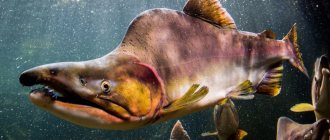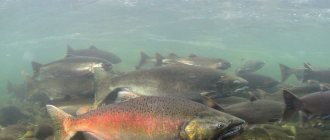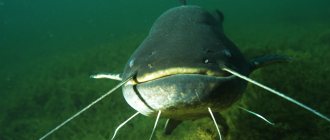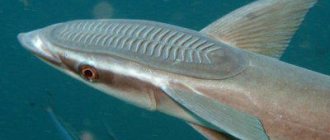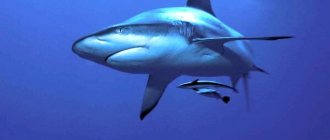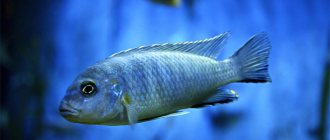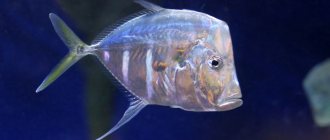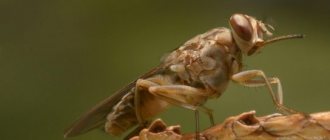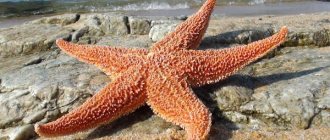- Wild animals
- >>
- Fish
Lionfish (Pterois) is a poisonous beauty from the scorpionfish family. Looking at this graceful, bright fish, you would not guess that it is a relative of the wart, the most disgusting fish of the family. In appearance, the lionfish cannot be confused with other fish. It got its name thanks to its long, ribbon-like fins that resemble wings. An inhabitant of the sea, the lionfish, immediately attracts attention with its bright colors. Other names are lion fish and zebra fish.
Origin of the species and description
Photo: Lionfish
In the previous classification of the lionfish genus, researchers identified many species identical to Pterois volitans, but only Pterois miles received serious confirmation as a similar species.
There are a total of 10 species in the genus Pterois, namely:
- P. andover;
- P. antennata - Antenna lionfish;
- P. brevipectoralis;
- P. lunulata;
- P. miles - Indian lionfish;
- P. mombasae - Mombasa lionfish;
- P. radiata - Radial lionfish;
- P. russelii;
- P. sphex;
- P. volitans - Zebra lionfish.
Video: Lionfish
After examining specimens throughout the Indo-Pacific region, the scientists concluded that these two isolated species can be recognized as P. miles in the Indian Ocean and as P. volitans in the western and south-central Pacific and Western Australia.
Fun fact: P. volitans is one of the most commonly used aquarium fish in many parts of the world. No other country except the United States and the Caribbean considers it an invasive species. Even in the US, it is one of the 10 most valuable marine fish imported into the country.
More recently, it was established that the range of lionfish extends to Sumatra, where different species coexist. The gap of more than two decades between these studies may lead us to believe that lionfish have expanded their range through natural spread over the years. The number of soft rays on the fins is commonly used to distinguish species belonging to the same genera.
Recent genetic work has shown that the Atlantic lionfish population consists primarily of P. volitans with a small number of P. miles. Because as venomous fish, lionfish are considered invasive by definition due to their likely impacts on native reef fish communities and human health.
Compliance of water parameters
Newly acquired fish should be quarantined
When you introduce a fish to another aquarium, it is very important that the water in its new home matches, if possible, the water to which it is accustomed. Otherwise, the fish may experience severe shock and even die.
We are talking about parameters such as the chemical composition of water and its temperature. Particularly dangerous is a sharp change in the pH value (pH shock), an increase in nitrate content (nitrate shock) and a change in temperature (temperature shock). Many fish died because their careless or ignorant owners did not realize the impending danger. Usually in such cases, aquarists blame an innocent seller for allegedly selling them low-quality fish. Exact matching of water parameters is necessary not only when you buy fish, but also when you transfer them from one aquarium to another at home.
Newly acquired fish should always be quarantined to minimize the risk of introducing any disease into the main aquarium. The water in the quarantine aquarium must correspond to that in which the fish were kept before, and all necessary changes must be made during quarantine.
Temperature equalization
Equalizing temperatures in the bag and aquarium
To avoid temperature shock, it is common to place the fish directly in a container with water poured from its previous aquarium into a new aquarium for a short time to allow the water temperatures to equalize. This may be the same container in which the fish were transported home from the store. If the fish is simply transferred from one aquarium to another without taking it out of the house, it can be a plastic bowl or box. The aquarium lighting should be turned off before the temperatures begin to equalize, so as not to stress the fish.
Before starting equalization, use a thermometer to measure the water temperature in both tanks - you may not need any equalization at all. Once you have some experience, you will be able to determine how long it will take for the temperatures to equalize. However, before releasing the fish from the container, be sure to double-check the water temperature in the container and in the aquarium. Sometimes it is advised to equalize temperatures within half an hour, but in practice this usually takes no more than five minutes. In addition, if you leave the fish floating in a container for a long time, it will experience severe stress.
Leveling the chemical composition of water
Leveling the chemical composition of water in the bag and aquarium
If you buy fish locally, they were most likely kept in local tap water, the parameters of which you should already know. If you buy fish somewhere far from home, then ask the store staff what the water hardness and pH value in their aquarium are, or take a sample of the water in which the fish are kept and have it analyzed. During quarantine, the chemical composition of the water in the quarantine aquarium can be gradually brought closer to the composition of the water in the main aquarium.
Many people believe that chemical shock can be avoided by repeatedly mixing small amounts of water from a new aquarium with the water contained in the container used to equalize temperatures. This is theoretically true, but only if this process continues for 48-72 hours and water is added only in very small portions. But in practice this is difficult to do, and fish kept in a container for a long time experience extreme stress, so it is better not to do this.
Nitrate levels
The water contained in pet store aquariums is usually of high quality, since it is constantly changed in small portions (after all, water is taken from aquariums to package sold fish), in addition to regular daily water changes. Unfortunately, the water in home aquariums is not always as good. Before introducing new fish into the main aquarium, it is necessary to determine the level of nitrogen compounds (nitrites and nitrates) in it. Although some books advise filling a quarantine aquarium with water from the main aquarium, this is not advisable if it has high levels of nitrites. Instead, use properly prepared tap water. In such cases, it is better to adapt the main aquarium to the new fish rather than vice versa. Before the new fish is introduced into the main aquarium, the nitrite levels in the aquarium should be gradually reduced through repeated partial water changes. It goes without saying that if the main aquarium is maintained properly, it should not contain a high concentration of nitrogen compounds.
Appearance and features
Photo: What a lionfish looks like
Lionfish (Pterois) is a genus of ray-finned fish belonging to the scorpionfish family (Scorpaenidae). They are distinguished by elongated feathery fins, bold patterns and extraordinary behavior. Adults reach a length of about 43 cm and weigh a maximum of 1.1 kg. Moreover, invasive individuals weigh more. Like other scorpionfish, the lionfish has large, feathery fins that protrude from its body, shaped like a lion's mane. The spiny projections on the head and venomous spines in the dorsal, anal and pelvic fins make the fish less desirable to potential predators.
The numerous fleshy projections on the head can mimic algae growth, camouflaging the fish and its mouth from prey. Lionfish have numerous small teeth on the jaws and on the top of the mouth, which are adapted for capturing and holding prey. Coloration varies, with lionfish characterized by thick vertical stripes of red, burgundy or red-brown, alternating with wider white or yellowish stripes. Ribs are spotted.
Interesting fact: In humans, lionfish venom causes severe pain and inflammation. Severe systemic symptoms such as respiratory distress, abdominal pain, seizures, and loss of consciousness may also occur. The lionfish's sting is rarely fatal, although some people are more susceptible to its venom than others.
Lionfish have 13 venomous dorsal rays, 9-11 dorsal soft rays, and 14 long, feather-like thoracic rays. The anal fin has 3 spines and 6-7 rays. Lionfish have a lifespan of 10-15 years. The lionfish is considered one of the most magnificent species for an aquarium. She has a beautifully striped head and body with reddish, golden brown or white stripes extending across a yellow background. Color may vary depending on habitat, with coastal species typically appearing darker, sometimes almost black.
Zebra fish lifestyle
In the underwater world, this fish chooses shallow zones, most preferring corals.
Like its land-based namesake, the lion fish is a real predator. This sea beauty has two methods of hunting: passive and active. When a lionfish hunts passively, it camouflages itself with its environment, which is helped by the coloring of its body, and waits for prey. When an unsuspecting prey swims by, the lion fish instantly grabs it and eats it. Active foraging involves intimidating the prey and swallowing it.
For zebra fish, the twilight lifestyle is more attractive; this fish prefers to spend daylight hours in crevices or underwater caves.
The lion fish rarely attacks itself.
Where does the lionfish live?
Photo: Lionfish
The native range of the lionfish is the western Pacific Ocean and the eastern Indian Ocean. They are found in the area between the Red Sea and Sumatra. Specimens of P. volitans were collected from Sharm el-Sheikh, Egypt and the Gulf of Aqaba, Israel, and near Inhaca Island, Mozambique. The lionfish's typical habitat is described as coastal coral reefs at depths of about 50 m. However, in their native range they also occur in shallow coastal and estuarine waters, with the highest densities occurring in shallower coastal waters. Large adults have been spotted at depths of 300 meters in the open ocean.
The lionfish's distribution also covers a vast area, stretching from western Australia and Malaysia east to French Polynesia and the Pitcairn Islands, north to south Japan and southern Korea, and south to Lord Howe Island off the east coast of Australia and the Kermadec Islands in New Zealand. This species is found throughout Micronesia. Lionfish are primarily associated with reefs, but are also found in the warm seawater of the tropics. They tend to glide along rocks and corals during the night and hide in caves and crevices during the day.
The introduced range includes most of the Caribbean and the southern east coast of the United States. Lionfish ended up in the coastal waters of Key Biscayne, Florida, when a local aquarium broke down during Hurricane Andrew in 1992. In addition, the deliberate release of aquarium pets contributed to an increase in the invasive population in Florida, which has already caused biological consequences.
Now you know where lionfish are found. Let's see what she eats.
Effect of poison
There is a sharp pain at the injection site. The following symptoms appear:
- numbness of an area of skin or an entire limb;
- swelling of the damaged area;
- redness, erythema.
Yandex.Pictures
As intoxication increases in the body, the following occurs:
- disturbances in cardiac activity;
- development of arrhythmia, angina pectoris;
- a sharp rise or fall in blood pressure;
- attacks of nausea or vomiting;
- seizures;
- severe weakness;
- difficulty breathing;
- fainting.
Ichthyologists warn vacationers not to go or swim too close to coral reefs and algae, so as not to touch them with their hands. If the lionfish senses danger, it attacks sharply. She is the first to not attack if she sees that no one is encroaching on her territory and life. People in most cases suffer from its accidental injections, and this is also a consequence of improper behavior of a person with dangerous fish.
What does a lionfish eat?
Photo: Lionfish
Lionfish are one of the highest levels of the food chain in many coral reef environments. They are known to feed primarily on crustaceans (as well as other invertebrates) and small fish, which include juveniles of their own species. Lionfish consume on average 8.2 times their weight. Their fry eat 5.5-13.5 g per day, and adults 14.6 g.
Sunset is the optimal time to start feeding because this is when coral reef activity is at its highest. At sunset, fish and invertebrates move to their nocturnal resting place, and all nocturnal fish come out to start hunting. Lionfish do not invest much energy in pursuing their prey. They simply slide up the rock, and the coral inhabitants themselves head towards the invisible predator. Moving slowly, the lionfish opens its pectoral rays to hide the movement of the caudal fin. This shielding, along with the predator's cryptic coloration, serves as camouflage and prevents detection by potential prey.
Fun Fact: While the colorful striped pattern of lionfish is noticeable and easy to spot in an aquarium, on a coral reef this colorful pattern allows the fish to blend into the background of coral fronds, feather stars and spiny sea urchins.
The lionfish attacks in one swift motion and sucks the prey completely into its mouth. It also hunts near the surface of the water using various techniques. The fish wait at a depth of 20-30 cm, watching as small schools of fish jump out of the water, trying to escape from other predators. When they dive back into the water, the lionfish is ready to attack.
Lionfish prey on:
- small fish (less than 10 cm);
- crustaceans;
- shrimp;
- small crabs and other invertebrates.
The fish hunts alone, slowly approaching its prey, finally grabbing it with a lightning-fast lunge with a snap of its jaws and swallowing it whole. Typically, lionfish feed on large amounts of fish when food is abundant and then starve when food is scarce.
First aid
If a person is pricked by a sea lion fish, it is important to provide him with first aid in a timely manner and contact medical specialists as quickly as possible. What should be done:
- Pull a person out of the water or help him get to land on his own. It is necessary to constantly stay close to the victim, since the poison can cause muscle paralysis and the person will not be able to swim or move independently.
- Rinse the bite area with clean, fresh water. This will help wash away the salt. Next, treat the wound with any antiseptic solution - Miramistin, Chlorhexidine, hydrogen peroxide. If there is no antiseptic, prepare a concentrated solution of soap and use it to wash the bite site.
- If breathing difficulties, severe weakness and fainting occur, begin performing chest compressions, artificial respiration and call emergency help.
If there are no disturbances in breathing or heart rhythm, you need to:
- Immerse the affected limb in hot water and leave for half an hour, constantly adding boiling water. This will help relieve pain;
- lubricate with anesthetic ointment or cream that has an antibacterial effect;
- to get rid of swelling, apply ice;
- consult a doctor.
Features of character and lifestyle
Photo: Zebra lionfish
These nocturnal fish move in the dark by slowly undulating the soft rays of their dorsal and anal fins. Although most lionfish feeding is completed during the first hour of the night, they continue to be out in the open until daylight. When the sun rises, the fish retreat to secluded places among the corals and rocks.
Lionfish as juveniles and during mating live in small groups. However, they are solitary for most of their adult lives and will fiercely defend their home range from others of the same or different species using their venomous dorsal fins.
Interesting fact: The pain caused by a lionfish bite in humans can last for several days and cause suffering, sweating and difficulty breathing. Experimental evidence suggests that the antivenom has a detoxifying effect on lionfish venom.
During courtship, males are especially aggressive. When another male invades the territory of a courting male, the agitated host approaches the invader with his fins spread wide. It then swims back and forth in front of the intruder, exposing its poisonous dorsal spines. The aggressive male turns darker in color and points his venomous, barbed dorsal fins at the other male, which folds its pectoral fins and swims away.
Danger to humans
This striped sea creature is dangerous to other fauna and people. The fins contain special glands that produce poison. When the lionfish senses danger, it quickly spreads its poisonous fins. Then he conducts an active attack, trying to prick his opponent. It looks scary. If suddenly, while swimming in the sea or ocean, you come across this beautiful colorful fish on your way, you should not touch it with your hands. Even one injection is dangerous to human health. And several injections are life-threatening.
Social structure and reproduction
Photo: Lionfish in the sea
Lionfish have amazing reproductive ability. They reach sexual maturity in less than a year and spawn year-round in warmer waters. Only during courtship does the lionfish form groups with other individuals of the species. One male teams up with several females, forming groups of 3-8 fish. Females produce between 15 and 30 thousand eggs per batch, so one fish in warm waters can produce up to two million eggs per year.
Fun Fact: When lionfish are ready to breed, the physical differences between the sexes become more obvious. Males become darker and more uniformly colored (their stripes are not as noticeable). Females with ripe eggs become, on the contrary, paler. Their belly, pharyngeal region and mouth become silvery white.
Courtship begins shortly before dark and is always initiated by the male. After the male finds the female, he lies down next to her on the substrate and looks at the surface of the water, resting on his ventral fins. Then he circles around the female and, after walking several circles, rises to the surface of the water, and the female follows him. When rising, the female's pectoral fins tremble. The pair can go down and up several times. On their final ascent, the pair floats just below the surface of the water. The female then releases the eggs.
The eggs consist of two hollow mucous tubes that float just below the surface when released. After about 15 minutes, these tubes fill with seawater and become oval balls with a diameter of 2 to 5 cm. Inside these slimy balls lie 1-2 layers of individual eggs. The number of eggs in the ball varies from 2000 to 15000. As the eggs appear, the male releases his sperm, which penetrates the mucous membranes and fertilizes the eggs inside.
20 hours after fertilization, embryos begin to form. Gradually, microbes penetrating inside destroy the mucus walls and 36 hours after fertilization the larvae hatch. Four days after conception, the larvae are already good swimmers and can begin to feed on small ciliates. They can spend 30 days in the pelagic stage, allowing them to disperse widely across ocean currents.
The Story of Life at the Zoo
This species is often kept in aquariums and zoo aquariums. Its food diet includes shrimp and small fish. Cases of spawning in zebra lionfish have been recorded under artificial conditions, but to date this species has not been bred in captivity.
The Moscow Zoo began keeping zebra lionfish in 1999. Currently, two zebra lionfish live in one 500-liter aquarium with two Mombasa lionfish, one antenna lionfish and one butterfly lionfish. The bottom of the aquarium is covered with a layer of gravel; Along the walls there are hollow acrylic decorations imitating rock relief with niches and shelters. Water temperature fluctuates in the range of 27 – 29 degrees C, salinity in the range of 34.5 – 36.0 ppm.
Zebra lionfish eat shrimp shells filled with minced meat, freshwater fish and freshwater amphipods. Feeding is carried out once every two days.
Natural enemies of lionfish
Photo: What a lionfish looks like
Lionfish are slow and act as if they are extremely confident or indifferent to threats. They rely on their coloration, camouflage and venomous spines to deter predators. Solitary adults usually remain in one place for a long time. They will fiercely defend their home range from other lionfish and other fish species. Few natural predators of lionfish have been recorded, even in their native range.
It is not entirely clear how lionfish populations are controlled in their natural range. They appear to be less affected by external parasites than other fish, both in the natural and invasive range. Within their invasive range, it is likely that sharks and other large fish predators have not yet accepted lionfish as prey. However, it is encouraging that lionfish have been found in the stomachs of groupers in the Bahamas.
Interesting fact: Human control of invasive lionfish is unlikely to achieve complete or long-term eradication or control. However, it may be possible to control lionfish populations in limited, selected areas through regular removal efforts.
In the Gulf of Aqaba, Red Sea, the blue-spotted whistler appears to be a predator of lionfish. Based on the presence of a large specimen of lionfish in its stomach, it was concluded that the fish uses its ambush tactics to securely capture the lionfish from the rear, holding it primarily by its tail. Recent observations of lionfish have shown a low prevalence of endo- and ectoparasites compared to parasites of native reef fishes.
Water acidity (pH)
Such a parameter as water acidity has a great influence on biochemical and biological processes and is important in the life of fish. Depending on the acidity, water is classified as follows: pH = 1-3 strongly acidic water 3-5 acidic water 5-6 slightly acidic water 7 neutral water 7-8 very slightly alkaline water 8-9 slightly alkaline water 9-10 alkaline water 10-14 highly alkaline water
The acidity of tap water is approximately 7pH. Many fish tolerate deviations from the neutral indicator quite painlessly (7). This is because the body has a number of systems that smooth out sharp fluctuations in pH.
In the processes of photosynthesis occurring in the light, plants consume carbon dioxide, which increases the pH level, and at night it decreases, which is associated not only with the lack of photosynthesis, but also with the release of CO2 during plant respiration. In general, in aquariums, biological oxidation processes prevail over reduction processes; In this regard, the acidity of the water decreases over time.
Strongly acidic, acidic, alkaline and highly alkaline water is not suitable for keeping aquarium fish. Water should be slightly acidic, neutral, very slightly alkaline. A sharp change in water acidity can cause fish death. To avoid this, you should change the water in small portions and pour water in small portions
Transferring fish from aquarium to aquarium must also be done carefully.
Increase pH level (make it more alkaline)
You can increase the level using drinking water, i.e. add drinking water to the water. You can also add some sodium bicarbonate or mix it with alkaline tap water. To increase the pH level to 7, i.e. To make it neutral, you should aerate it or boil it.
Lower the pH level (make it more acidic)
You can add a little peat to the water, taken from uplands, or a filtered extract obtained after boiling peat. You can also acidify the water using sodium biphosphate. Measure pH level. You can measure the level at home using indicator papers. The determination boils down to dipping a strip of indicator paper into aquarium water and quickly comparing the acquired color with a standard scale. There is indicator paper for both rough pH measurements from 1 to 10, and for more precise determination of pH in any of the narrow ranges.
Vallisneria americana
Vallisneria americana var. americana
The plant is unpretentious and does not require much attention. Vallisneria americana has many forms that differ in the width and length of the leaves.
| Habitat: eastern North America. Form and appearance: leaves are collected, in the form of a rosette, ribbon-shaped, brittle and soft, sometimes with teeth along the edges. Representatives of the subspecies of American Vallisneria may differ in the structure of the leaf blade and its color (from various shades of green to many shades of red). Narrow-leaved forms: leaf width is about 10 mm, with several veins and clearly defined horizontal strokes. Broad-leaved forms: leaf width up to 25 mm, veins can be from 5 to 9 pieces. Soil: loose, rich in useful substances, up to 7 cm thick, in tandem with liquid and horse fertilizers, which contain iron, is the best option for the full development of the plant. Lighting: bright, 12-hour daylight hours. Water parameters: Comfortable temperature: 20-28°C. “Acidity” Ph: 6.5-8. Hardness dH: 5-15°. |
Placement in an aquarium: when planting Vallisneria in your aquarium, you should remember that the plant grows up to 1 m in height, so it can significantly worsen the lighting of the underwater world of your pond. If you still decide to get such aquatic grass, then select the inhabitants of the aquarium that accept dim light.
It is worth noting that Vallisneria americana is most attractive in very large aquariums. A good planting option is about 4 plants per 20 cm2.
Vallisneria americana is a background plant, so it is planted along the back and side walls of the aquarium.
Difficulty of care: low.
Trimming: You can trim the leaves, but you don't have to. After pruning, the appearance of the plant deteriorates and growth weakens.
Reproduction: vegetative, uniform.
Habitat expansion
Under favorable conditions, the fish develops quite quickly, which causes concern. For example, in recent years, lionfish have appeared in popular resorts in Cuba, Florida, Haiti, etc. First of all, this is dangerous for lovers of sea holidays, since it can easily be ruined by stepping on where the fish are resting. But that’s not all. Since under favorable conditions the lionfish reproduces very quickly and is a predatory individual, it poses a danger to other marine inhabitants, in particular smaller ones. Most likely, scientists will soon take some measures to reduce the lion fish population.
